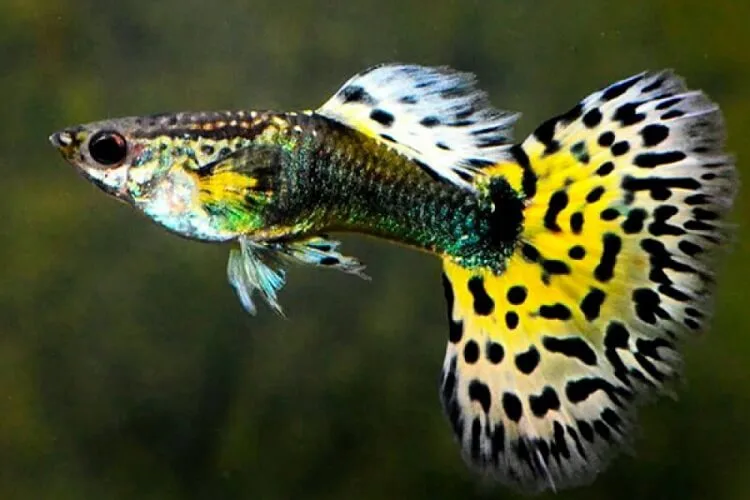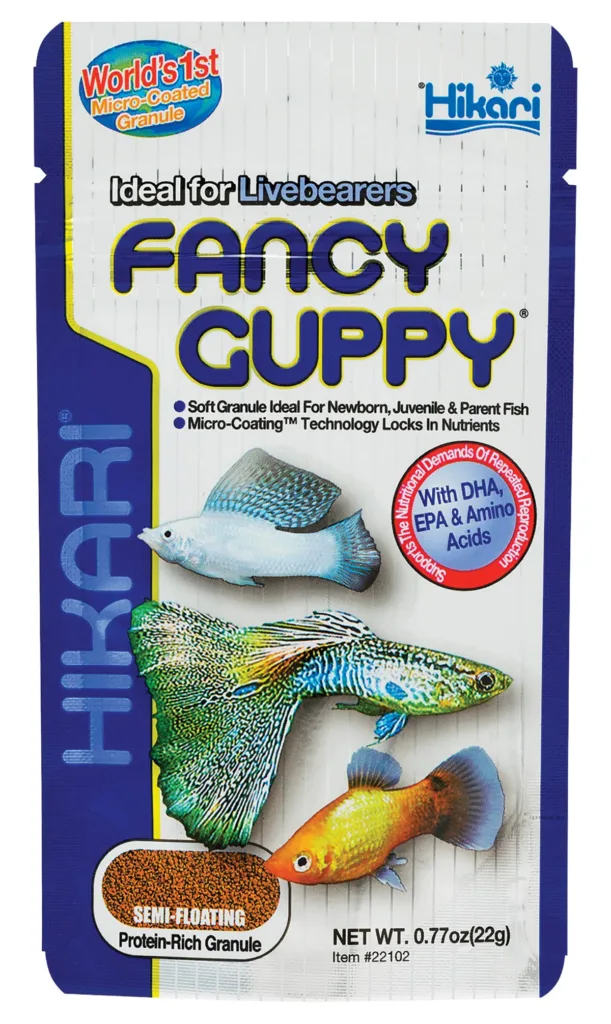White Leopard Guppy care guide, a captivating variety of the popular guppy fish, are renowned for their striking appearance and relatively easy care requirements. In this comprehensive care guide, we’ll delve into the world of White Leopard Guppies, covering everything from their mosaic patterns and origins to tank setup, breeding, feeding, common diseases, and more. Whether you’re a beginner aquarist or an experienced fish enthusiast, this guide will provide you with valuable insights on how to care for these beautiful aquatic companions.
What is a Mosaic in White Leopard Guppies?
Before we dive into the care specifics, it’s crucial to understand the unique feature that sets White Leopard Guppies apart from other guppy variations – their mosaic pattern. The term ‘mosaic’ refers to the intricate arrangement of colors and patterns on the guppy’s body. White Leopard Guppies exhibit a remarkable mosaic that combines varying shades of white and other colors, creating a stunning and eye-catching appearance. The mosaic is more pronounced in males, making them particularly attractive additions to your aquarium.
Appearance

White Leopard Guppies appearance. Understanding their distinct characteristics is essential for their proper care.
Males:
- Size: White Leopard Guppy males typically reach a length of 1.2 to 1.6 inches.
- Coloration: Their bodies are primarily white with splashes of other colors like gray, black, or blue. The colors may form intricate patterns reminiscent of a leopard’s spots.
- Tail Fins: Males often have elongated, colorful tail fins, adding to their appeal.
- Dorsal Fin: Their dorsal fin is a prominent feature, displaying vibrant colors and sometimes intricate patterns.
White leopard guppy care guide female
- Size: White Leopard Guppy females are slightly larger than males, reaching around 1.6 to 2 inches.
- Coloration: While females also possess the white base color, their patterns are generally less pronounced than males.
- Gravid Spot: Look for a gravid spot, a dark area near the anal fin, which can indicate their readiness for breeding.
It’s important to note that White Leopard Guppies may exhibit variations in color and patterns, which is part of their charm. These variations often result from selective breeding, and you can find unique individuals that stand out in your aquarium.
Origin of white leopard guppies
The guppy, scientifically known as Poecilia reticulata, is native to various parts of Central and South America. White Leopard Guppies, however, are not a product of nature but rather a creation of dedicated breeders. They have been selectively bred over generations to achieve their distinct white base color with leopard-like patterns.
The White Leopard Guppy is a domesticated fish that was first bred in captivity in the 1960s. It is believed to have originated from the wild guppies of South America.
White Leopard guppy Tank Setup

Proper tank setup is essential to ensure the well-being of your White Leopard Guppies. Here are the key factors to consider: (How to Set Up a Guppy Fish Tank: The 10 Step Guide for Beginners on setting up a guppy fish tank)
Tank Size: What size Tank should I get for my leopard guppy
The White Leopard Guppy is a relatively hardy fish, but it still needs a clean and well-maintained tank to thrive. The recommended tank size for a group of White Leopard Guppies is at least 10 gallons. The tank should be equipped with a filter and a heater to keep the water temperature at a comfortable level (72-78 degrees Fahrenheit).
The White Leopard Guppy is a tropical fish, so it needs warm water. The ideal water temperature for White Leopard Guppies is 72-78 degrees Fahrenheit. The water should also be slightly alkaline, with a pH of 7.0-7.5.
White Leopard Guppies are active fish, so they need plenty of swimming space. However, they also appreciate having some hiding places, such as live plants or rocks.
Filtration:
A good quality aquarium filter is vital to maintain water quality. Guppies are sensitive to ammonia and nitrite levels, so ensure your filter effectively removes these harmful substances. (The Best Guppy Fish Tank Filter: How to Choose the Right Filter for your guppy fish tank)
Heating:
White Leopard Guppies are tropical fish and thrive in water temperatures between 75°F to 82°F (24°C to 28°C). A reliable aquarium heater can help maintain a stable temperature.
Substrate and Decor:
Use fine gravel or sand as the substrate, as guppies like to forage in the substrate. Adding plants, caves, and decorations provides hiding spots and stimulates natural behaviors.
Water Quality:
Regular water changes, typically 10-20% of the tank volume weekly, are crucial to maintain water quality. Guppies prefer slightly alkaline water with a pH of 7.0 to 7.2.
Lighting:
White Leopard Guppies don’t have specific lighting needs, but moderate lighting is ideal for plant growth in the aquarium.
Companions:
Guppies are generally peaceful, but avoid keeping them with aggressive or fin-nipping fish. Opt for peaceful tankmates like other guppy varieties, neon tetras, or mollies.
Breeding white leopard guppies
White Leopard Guppies are known for their prolific breeding, making them a popular choice for aquarists interested in breeding fish. Here’s what you need to know about their breeding habits: (How to Breed Guppies: A Comprehensive Step By Step Guide)
Male to Female Ratio:
To initiate breeding, maintain a higher ratio of females to males, typically one male for every two to three females. This prevents excessive male harassment and stress on females.
Gestation Period:
Guppy females are livebearers, which means they give birth to live fry instead of laying eggs. The gestation period is approximately 28 days, but it can vary based on factors like water temperature and the female’s age.
Fry Care:
Separate pregnant females from the main tank to protect fry from potential predation by adults. You can use a breeding box or a separate tank for this purpose.
Feeding Fry:
Fry should be fed specialized fry food or finely crushed flake food. Ensure they receive proper nutrition to support their growth.
Guppy Fry Growth:
Guppy fry grow quickly, and they will start to develop their mosaic patterns as they mature. This is a fascinating process to observe.
Overpopulation Control:
Be prepared for a growing guppy population. If your tank becomes overcrowded, consider giving away or selling the excess guppies to maintain a healthy and balanced aquarium ecosystem.
Feeding leopard white guppies

Proper nutrition is vital for the health and vitality of White Leopard Guppies. They are omnivorous and have a diverse diet.
Staple Diet:
High-quality guppy flakes or pellets form the staple of their diet. Look for foods specifically designed for guppies to meet their nutritional needs.
Live and Frozen Foods:
Variety is key. Supplement their diet with live or frozen foods like brine shrimp, daphnia, and bloodworms. These foods mimic their natural diet and enhance their coloration.
Feeding Frequency:
Feed your guppies small portions multiple times a day. They have tiny stomachs and need regular meals to stay healthy.
Avoid Overfeeding:
Be cautious not to overfeed, as excess food can lead to water quality issues. Only provide what your guppies can consume in a few minutes.
Vegetable Matter:
Guppies also benefit from some vegetable matter in their diet. Blanched spinach or cucumber can be offered as an occasional treat.
Diseases
Preventing and addressing common diseases is crucial to maintaining the well-being of your White Leopard Guppies.
Ich (White Spot Disease):
Ich is a parasitic disease characterized by small white spots on the fish’s body. It’s treatable with commercial medications and by raising the tank temperature to 86°F (30°C) for several days.
Fin Rot:
Fin rot is a bacterial infection that causes fraying
and deterioration of the fins. Maintain excellent water quality and use antibiotics to treat severe cases.
Dropsy:
Dropsy is a severe condition resulting in bloating and scales that stick out. It can be challenging to treat, but early detection and isolation of affected fish can help prevent the spread of the disease.
Velvet Disease:
Velvet disease appears as a gold or rust-colored dust on the guppy’s skin and gills. It’s treated with copper-based medications.
Quarantine New Fish:
Always quarantine new fish for a few weeks before introducing them to your main tank to prevent the spread of diseases.
Where to buy white leopard Guppies
You can buy White Leopard Guppies from a variety of places, including:
- Local fish stores: Many local fish stores sell White Leopard Guppies. It is important to find a reputable fish store that sells healthy fish.
- Online retailers: There are a number of online retailers that sell White Leopard Guppies. It is important to do your research before purchasing fish online to make sure that the retailer is reputable and that the fish will be shipped safely.
- Breeders: You can also purchase White Leopard Guppies from breeders. This is a good option if you are looking for a specific type of White Leopard Guppy, such as a high-quality show fish.
When purchasing White Leopard Guppies, it is important to inspect the fish carefully to make sure that they are healthy. Look for fish that are active and have clear eyes and fins. Avoid fish that are lethargic or have any signs of disease.
Here are some additional tips for buying White Leopard Guppies:
- Ask the fish store employee or breeder about the fish’s health history.
- Find out how the fish were raised and what they were fed.
- Ask about the fish’s temperament.
- Make sure that the fish are the appropriate size for your tank.
- Avoid purchasing too many fish at once, as this can stress the fish and make them more susceptible to disease.
Once you have purchased your White Leopard Guppies, it is important to quarantine them for two weeks before adding them to your main tank. This will help to prevent the spread of disease to your other fish.
How much do white leopard guppies cost?
The price of White Leopard Guppies varies depending on a number of factors, such as the quality of the fish, the size of the fish, and the location where you purchase the fish.
In general, White Leopard Guppies cost between $5 and $20 per fish. However, high-quality show fish can cost significantly more such as breeding pairs which can go as high as $50 per a pair.
Here are some factors that can affect the price of White Leopard Guppies:
- Quality of the fish: High-quality fish with good genetics and coloration will typically cost more than lower-quality fish.
- Size of the fish: Larger fish will typically cost more than smaller fish.
- Location where you purchase the fish: Fish prices can vary depending on the location. For example, fish may be more expensive in cities than in rural areas.
If you are looking for a good deal on White Leopard Guppies, it is a good idea to shop around and compare prices from different retailers. You may also want to consider purchasing fish from a breeder, as breeders often offer discounts for bulk purchases.
Here are some tips for saving money on White Leopard Guppies:
- Buy fish from a breeder.
- Purchase fish in bulk.
- Look for sales and discounts.
- Consider buying fish online.
It is important to note that the cheapest fish are not always the best value. It is better to spend a little more money on a high-quality fish that is healthy and has good genetics.
In conclusion, White Leopard Guppies are a captivating addition to your aquarium, showcasing their mosaic patterns and vibrant personalities. By providing them with an appropriate tank setup, understanding their breeding habits, offering a balanced diet, and being vigilant about disease prevention, you can ensure that your White Leopard Guppies thrive in your care. Their unique appearance and relatively undemanding care requirements make them an excellent choice for aquarists of all levels of experience.










